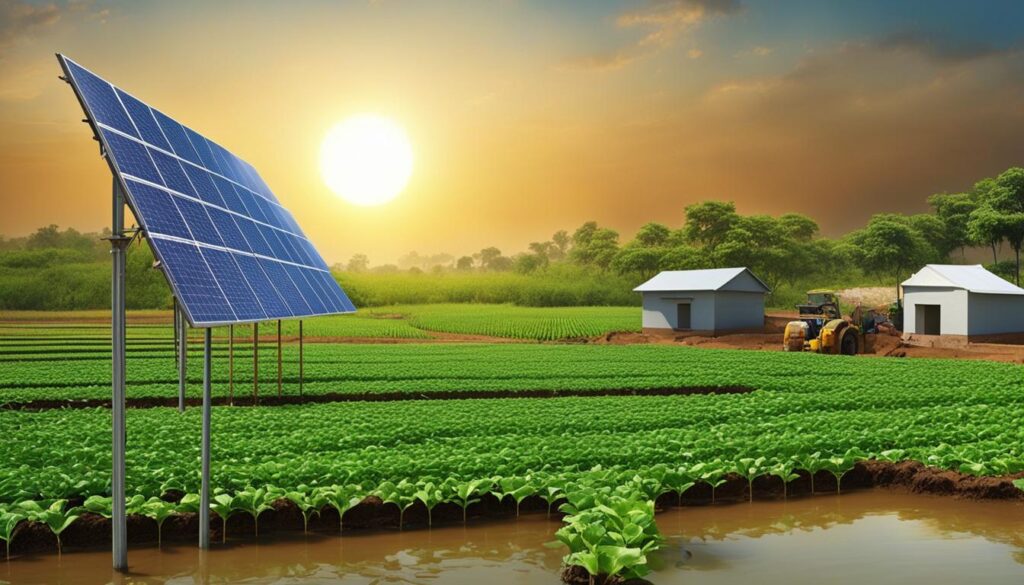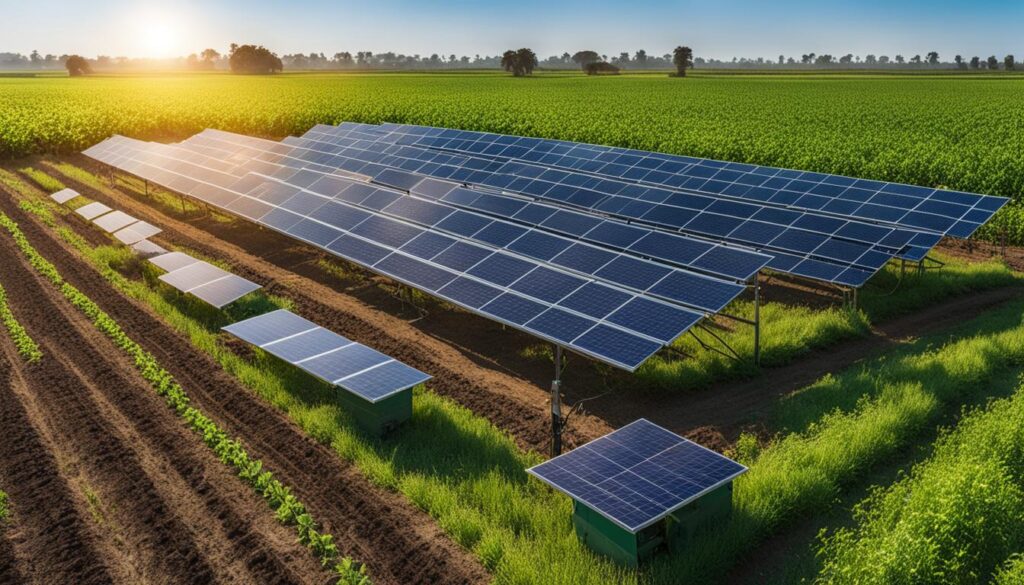The Kusum Solar Pump Yojana is a remarkable initiative by the Indian government to revolutionize the agricultural sector. This visionary scheme aims to provide sustainable irrigation solutions to farmers by harnessing the power of renewable energy. Through this program, farmers can avail themselves of solar pumps at a subsidized rate, reducing their dependence on conventional energy sources such as diesel or electricity.
Under the Kusum Solar Pump Yojana, the government seeks to promote the adoption of solar energy in agriculture, thereby improving the economic and environmental sustainability of farming practices. By embracing this subsidy scheme, farmers can not only reduce their electricity expenses but also increase their income through surplus energy generation. This environmentally friendly approach not only benefits individual farmers but also contributes to a greener and more sustainable future for India’s agricultural sector.
Key Takeaways:
- The Kusum Solar Pump Yojana provides sustainable irrigation solutions to farmers through the use of renewable energy.
- Farmers can install solar pumps at a subsidized rate, reducing their dependence on traditional energy sources.
- The scheme aims to promote the adoption of solar energy in agriculture and improve the economic and environmental sustainability of farming practices.
- By availing the benefits of the Kusum Solar Pump Yojana, farmers can reduce their electricity expenses, increase their income through surplus energy generation, and contribute to a greener and more sustainable future for India’s agricultural sector.
- This initiative empowers farmers, enhances agricultural practices, and promotes the use of renewable energy for a more sustainable and prosperous India.
Key Components of the PM Kusum Yojana
The PM Kusum Yojana is designed to drive the adoption of renewable energy in the agricultural sector. It consists of three main components that aim to provide farmers with a reliable and sustainable source of power for irrigation, reduce their dependence on grid electricity, and promote the generation of renewable energy on a decentralized scale. These components are:
Component A: Grid-Connected Solar Power Plants
Under Component A of the PM Kusum Yojana, the focus is on the establishment of grid-connected solar power plants with a capacity of up to 2 MW. These power plants are connected to the national grid and play a crucial role in promoting the generation of renewable energy in the agricultural sector. By setting up these solar power plants, farmers can contribute to a greener future while also reducing their electricity costs.
Component B: Standalone Solar Pumps in Off-Grid Areas
Component B of the PM Kusum Yojana aims to install standalone solar pumps in off-grid areas. These pumps have a capacity of up to 7.5 HP and provide farmers with a reliable and renewable source of power for irrigation. By utilizing solar energy, farmers can ensure a steady supply of water for their agricultural activities without relying on the grid. This component of the scheme is particularly beneficial for farmers in remote areas with limited access to electricity.
Component C: Solarization of Grid-Connected Agriculture Pumps
Component C focuses on solarizing existing grid-connected agriculture pumps. This component allows farmers to convert their traditional pumps into solar-powered ones, reducing their dependence on grid electricity. The solarization process involves individual pump installations as well as feeder-level solarization, depending on the specific needs of the farmers. By embracing solar energy, farmers can lower their energy costs and contribute to a more sustainable farming ecosystem.

By implementing these key components of the PM Kusum Yojana, farmers can access financial assistance, subsidies, and low-interest loans to make the transition to renewable energy more affordable and accessible. This renewable energy subsidy program empowers farmers to adopt solar energy, reduce their carbon footprint, and contribute to India’s sustainable development.
Benefits of the Kusum Solar Pump Yojana
The Kusum Solar Pump Yojana offers numerous benefits to farmers and the agricultural sector. Firstly, by installing solar pumps, farmers can significantly reduce their electricity expenses, as solar energy is a renewable and cost-effective alternative to conventional energy sources. This reduction in expenses can improve the financial stability of farmers and increase their income.
Moreover, solar pumps provide a reliable source of power for irrigation, ensuring a steady supply of water for agricultural activities even in remote areas with limited access to grid electricity. Farmers can rely on solar pumps to efficiently water their crops, resulting in better yields and improved productivity.
Additionally, the scheme promotes the diversification of income for farmers by allowing them to generate surplus solar energy and sell it back to the grid. This enables farmers to become not only consumers of energy but also producers, contributing to the overall energy supply and earning additional income.
Furthermore, the adoption of solar energy through the Kusum Solar Pump Yojana contributes to a more sustainable and eco-friendly farming ecosystem. By reducing reliance on fossil fuels and mitigating greenhouse gas emissions, the scheme helps in reducing the carbon footprint of the agricultural sector and preserving the environment for future generations.
The Kusum Solar Pump Yojana empowers farmers, enhances agricultural practices, and promotes the use of renewable energy for a more sustainable and prosperous India. By harnessing the power of the sun, farmers can improve their livelihoods, increase productivity, and contribute to the country’s green energy goals.
FAQ
What is the Kusum Solar Pump Yojana?
The Kusum Solar Pump Yojana is a transformative initiative by the Indian government aimed at providing sustainable irrigation solutions to farmers through the use of renewable energy. It offers subsidies for farmers to install solar pumps, reducing their dependence on traditional energy sources.
What are the key components of the PM Kusum Yojana?
The PM Kusum Yojana comprises three main components. Component A focuses on the establishment of grid-connected solar power plants, Component B aims to install standalone solar pumps in off-grid areas, and Component C focuses on solarizing existing grid-connected agriculture pumps.
How does the installation process for solar pumps work under the Kusum Solar Pump Yojana?
The installation process involves individual pump installations as well as feeder-level solarization, depending on the specific needs of the farmers. The government provides financial assistance, subsidies, and low-interest loans to make the transition to renewable energy more affordable and accessible.
What are the benefits of the Kusum Solar Pump Yojana?
The Kusum Solar Pump Yojana offers numerous benefits to farmers and the agricultural sector. It significantly reduces electricity expenses, provides a reliable source of power for irrigation, promotes income diversification through surplus energy generation, and contributes to a more sustainable and eco-friendly farming ecosystem.

